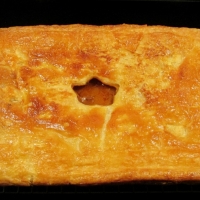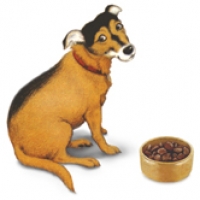Neerday Steak Pie
From sitbynellie 16 years agoIngredients
- 1 kg (2 1/4 lbs.) stewing (shoulder) steak - in the US this is called chuck steak. shopping list
- If you like it, substitute 225g (1/2 lb.) of the beef for ox kidney, cored and trimmed (not traditional!) shopping list
- salt and pepper shopping list
- 40g (approx. 1 1/2 oz.) beef dripping shopping list
- 2 medium-sized onions, chopped shopping list
- 2 tbsp. plain flour shopping list
- 2 tsp. worcestershire sauce (again, not traditional but so what) shopping list
- 2 tsp. tomato puree (ditto) shopping list
- 1/2 level tsp. dried thyme (ditto) shopping list
- 450 ml. (just under a pint) beef stock (you can use powder or stock cubes if in a hurry) shopping list
- 350g (12 1/2 oz.) ready-made puff-pastry shopping list
- 1 medium egg, lighly beaten shopping list
- Some more hot beef stock for finishing shopping list
How to make it
- Cut the beef and kidney (if using) into bite-sized pieces.
- Season with the salt and pepper to your taste.
- Melt 2 tbsp. of the dripping in a large flameproof casserole dish.
- Brown the meat thoroughly, in batches. Remove the meat and keep warm.
- In the remaining fat, fry the onion until lightly browned.
- Add the flour, stir in well and continue to cook gently (add a little more fat if it's too dry), until the mixture is a good shade of brown, but not burnt!
- Stir in the Worcestershire sauce and the tomato puree, beef stock, and browned meat, and bring up to the boil slowly (about five minutes).
- Cover and simmer on a very low heat for 1 1/2 - 2 hours until the meat is very tender.
- Cool the meat a little.
- Preheat the oven to Gas Mark 6/200C/400F).
- Then transfer the meat to a 1.2 litre (2 1/2 pint) pie dish (we usually use a rectangular white enamelled one, but use what you have).
- Brush the rim of the pie dish with a little of the egg.
- Roll the pastry out (if not pre-rolled) and cut out, a little bigger than the edge of the pie dish.
- Lay the pastry on top, carefully, and trim. Press the edges down lightly. Brush the top with the rest of the egg.
- Cut a little hole in the middle of the pastry.
- Bake for 30 minutes until the top is golden.
- Before serving, pour in, through the hole, some more hot beef stock as the filling will have lost some moisture during baking.
- Serve with potatoes and veg. of your choice!
- Well, now that Christmas Day is past, we in Scotland are getting ready for Hogmanay, our annual New Year festival. Want to know a little more?
- Some of the following is from Wikipedia, some of it is mine. Wiki's bits are in quotes.
- 'The etymology of the word is obscure. It may have been introduced to Middle Scots through the ‘Auld Alliance’. In 1604 the custom was mentioned in the Elgin Records as hagmonay. The most satisfactory explanation is a derivation from the Northern French dialect word hoguinané, or variants such as hoginane, hoginono and hoguinettes. Those being derived from 16th century Old French aguillanneuf which is either a gift given at New Year, a children's cry for such a gift or New Year's Eve itself.'
- 'The Presbyterian Church generally disapproved of Hogmanay. The following quote is one of the first mentions of the holiday in official church records:
- 'It is ordinary among some plebeians in the South of Scotland to go about from door to door upon New-years Eve, crying Hagmane.’
- Until the 1960s, Hogmanay and Ne'erday (a contraction of 'New Year's Day' in Scots dialect, according to the OED) in Scotland took the place of Christmas Eve and Christmas Day in the rest of the UK. Although Christmas Day held its normal religious nature, the Presbyterian national church, the Church of Scotland, had discouraged its celebration for over 400 years. As a result Christmas Day was a normal working day in Scotland until the 1960s and even into the 1970s in some areas. The gift-giving, public holidays and feasting associated with mid-winter were held between the 31 December and 2 January rather than between 24 December and 26 December.
- With the fading of the Church's influence and the introduction of English and other cultural values via television and immigration, the transition to Christmas feasting was well-nigh complete by the 1980s. However, 1 January and 2 January remain public holidays in Scotland, despite the addition of Christmas Day and Boxing Day to the public holiday list, and Hogmanay still is associated with as much celebration as Christmas in Scotland.'
- The most emotional moment of Hogmanay is the moment of midnight, known as 'The Bells'. To be present with someone at their New Year's is to help them 'Bring in the Bells'. Big Ben in London, televised, begins to strike the hour, and at the First stroke of midnight, embraces and toasts are shared, (everyone must have a full glass) and good luck is wished, and some tears are shed.
- 'The Hogmanay custom of singing Auld Lang Syne has become common in many countries. Auld Lang Syne is a traditional poem reinterpreted by Robert Burns, which was later set to music. It is now common for this to be sung in a circle of linked arms that are crossed over one another as the clock strikes midnight for New Year's Day, although in Scotland the traditional practice is to cross arms only for the last verse.’
- In many households, the windows are opened to let out the old year, and to let in the new one. If you live near a sea or river port, you can hear the ships in harbour sounding their horns for many minutes.
- Thanks to TV, we can hear the lone piper playing on the ramparts of Edinburgh Castle and the cannon (usually fired at one o' clock p.m. every day during the year) is fired, by a soldier of the regiment currently garrisoning the Castle.
- 'As in much of the world, the largest Scottish cities, Glasgow, Edinburgh and Aberdeen hold all-night celebrations, as does Stirling The Edinburgh Hogmanay celebrations are among the largest in the world.'
- 'The most widespread national custom is the practice of 'first-footing' which starts immediately after midnight. This involves being the first person to cross the threshold of a friend or neighbour and often involves the giving of symbolic gifts such as salt (less common today), coal, shortbread, whisky, and black bun (a rich fruit cake) intended to bring different kinds of luck to the householder. Food and drink are then given to the guests. This may go on throughout the early hours of the morning and well into the next day (although modern days see people visiting houses until 3 January). The first-foot is supposed to set the luck for the rest of the year.’
- The First-foot, (sometimes this is one of the guests who has been shoved out in the cold before the Bells to wait till midnight!) then knocks at the door and is welcomed in. It's preferable for your First-foot to be tall and dark as this is considered more auspicious.
- Haste ye back, we loue you dearly,
- Call again you're welcome here.
- May your days be free from sorrow,
- And your friends be ever near.
- May the paths o'er which you wander,
- Be to you a joy each day.
- Haste ye back we loue you dearly,
- Haste ye back on friendship's way.
- See the ‘Hangover Cures’ group too!
The Rating
Reviewed by 8 people-
great post....and back ground info... thank you..five forks
 peetabear
in mid-hudson valley loved it
peetabear
in mid-hudson valley loved it
-
Wow how interesting Susan! Great recipe and information... Thank you so much for taking the time to share it with us. 5 forks
 gourmetana
in London loved it
gourmetana
in London loved it
-
canae better a good steak pie!!!! and this looks realy good!!!
 foyboy77
in Fife loved it
foyboy77
in Fife loved it







Reviews & Comments 7
-
All Comments
-
Your Comments
" It was excellent "
" It was excellent "
" It was excellent "
" It was excellent "
" It was excellent "
" It was excellent "
" It was excellent "